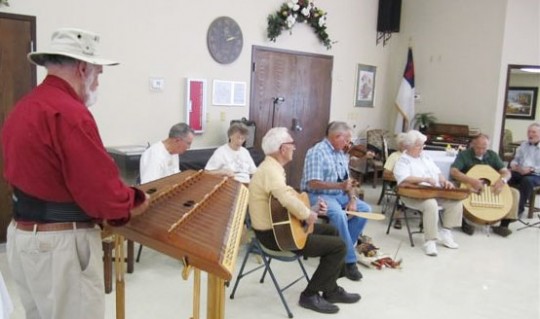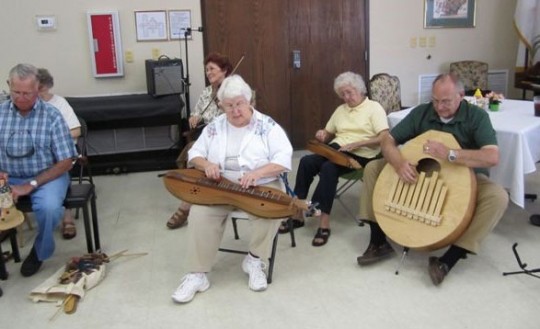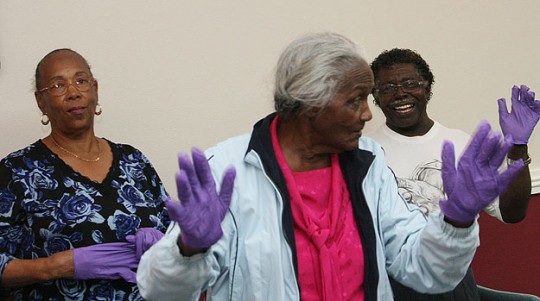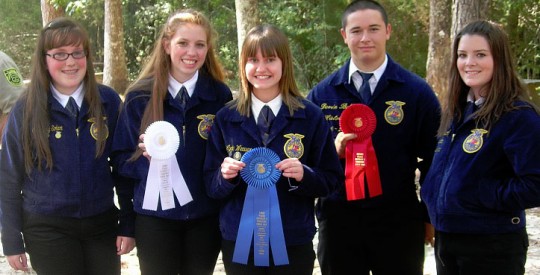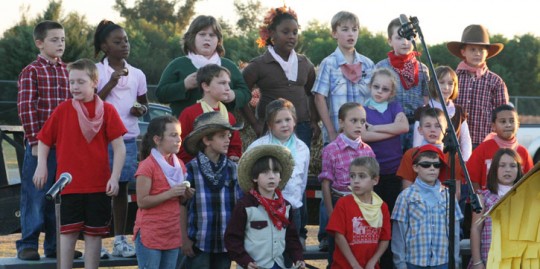Flomaton Celebrates Fall, Hurricanes
October 22, 2010
Characters of all sorts roamed the streets of downtown Flomaton Thursday night during the town’s annual Fall Festival. The event also included a big homecoming pep rally for the Flomaton Hurricanes.
The Fall Festival began a weekend of activities as part of the 2010 Flomaton Great Homecoming. Events continue with a homecoming parade and homecoming football game on Friday and a full day of activities on Friday. Click here for more information.
Submitted photo for NorthEscambia.com, click to enlarge.
Over 100 Work To Clean Up Area Waterways
October 20, 2010
Over 100 people recently worked to clean up over 35 miles of North Escambia area waterways.
The cleanup was part of the Alabama Coastal Cleanup across several Alabama counties as well as Escambia County in Florida.
 The largest group participating in the event was organized by Jerry Fischer and friends from Century. The group cleaned over 35 miles of shoreline in Alabama and Florida along the Escambia River, Conecuh River, Little Escambia Creek, Big Escambia Creek, Bluff Springs, Pollard and Murder Creek.
The largest group participating in the event was organized by Jerry Fischer and friends from Century. The group cleaned over 35 miles of shoreline in Alabama and Florida along the Escambia River, Conecuh River, Little Escambia Creek, Big Escambia Creek, Bluff Springs, Pollard and Murder Creek.
Adults and students from the Century, Jay, Brewton and Flomaton areas participated. The youngest volunteer was Chance Thornton, Fischer’s 5-yard old grandson. Century Mayor Freddie McCall personally donated the use of a garbage dumpster for the group.
This international Coastal Cleanup event serves as a public service as well as an educational tool to help teach both adults and students the grave effects that littering has on our environment, specifically to aquatic life, according to area organizer Janet Wofford. Since Alabama joined the International Coastal Cleanup in 1987, over 58,000 have volunteered for the event and over 1 million pounds of trash has been removed from shorelines and waterways.
Pictured above: Volunteers from the North Escambia area take a break at Bluff Springs, Fla., during the annual Alabama Coastal Cleanup. Pictured inset: The youngest volunteer was 5-year old Chance Thornton. Submitted photo for NorthEscambia.com, click to enlarge.
Dogwood Dulcimers Entertain Century Care Residents, To Hold Jam Sessions At Lake Stone
October 20, 2010
The Dogwood Dulcimer Association performed Tuesday for the residents of the Century Care Center. This weekend, they will hold a jam session at Lake Stone.
For more photos from the Century Care Center performance, click here.
The jam session scheduled for the weekend at Lake Stone includes:
- Friday
- 6 pm Covered dish supper
- 7 pm Homemade Jam Session
- Saturday
- 1 pm Open stage
- 6 pm No pot luck supper (supper on your own)
- 7 pm Homemade Jam Session
- Sunday
- 9 a.m. Music Service
For festival information, contact Yvonne Ward at (850) 626-9981 or (850) 982-1997 or Glen McDaniel at (850) 478-8193.
The Dogwood Dulcimers invites anyone, including beginners, to play a dulcimer or traditional instrument with them for free. The group meets every Monday at 7 p.m. at Trinity Presbyterian Church at 3400 Bayou Blvd., Pensacola and the second Thursday of each month, 7 p.m. at Cottage Hill United Methodist Church at 229 Williams Ditch Road in Cantonment.
Click here for the Dogwood Dulcimer website.
Pictured above and below: The Dogwood Dulcimers perform Tuesday afternoon at Century Care Center. Submitted photos for NorthEscambia.com, click to enlarge.
Century Council Does The ‘Purple Glove Dance’
October 19, 2010
Members of the Century Town Council did the “Purple Glove Dance” Monday night in support of the Century Relay for Life.
Relay Chairperson Jacke Johnston told the council and audience members that their moves in purple gloves would be used in a video to promote the Century Relay. Other businesses and community groups are also being videoed for the presentation that will be shown at an October 26 Relay kickoff event.
For more purple glove dance photos from Monday night’s Century Town Council meeting, click here.
We also expect to make the video available here on NorthEscambia.com. (And yes…if they don’t cut the segment out of the video…William from NorthEscambia.com and Janet Cooper from the Tri-City Ledger will also be in the video in the fashionable purple gloves.)
NorthEscambia.com photos, click to enlarge.
Tate Band Ranked Superior, Set To Perform On Extreme Home Makeover
October 19, 2010
The Tate High School Showband of the South earned straight superiors at a weekend competition, and they will be performing in a weekend Christmas parade for Extreme Home Makeover.
The band was ranked superior in marching and maneuvering, general effect, music, axillary and received a final overall superior rating at the District 1 Florida Bandmasters Association’s Music Performance Assessment in Fort Walton Beach. Over 1,000 band students from across Escambia and Santa Rosa counties took part in the event.
Escambia, Milton, Pace and Pine Forest high schools also earned straight superior ratings.
The Tate High School Showband of the South is scheduled to perform a “Christmas Parade” Sunday afternoon for ABC’s Extreme Home Makeover as the the program’s house is revealed to the shouts of “Move That Bus!” in Pensacola. It will be the band’s second performance nationally on ABC in a year; the Tate Showband of the South was the only band selected to perform at the 2009 Disney Christmas Parade that aired Christmas morning on ABC television.
Pictured top: The Tate High School Showband of the South performs in the 2009 Disney Christmas Parade. NorthEscambia.com file photo, click to enlarge.
Miracle Girl, Miracle League
October 18, 2010
Miracles do happen.
We first introduced you to Olivia Bush, 7, in December 2009 in a story titled “A Christmas Wish: A Cure For Olivia”. She is blind, able to see just a little light with her left eye. And she suffered frequent seizures — until a portion of her brain was removed in February of this year at Miami Children’s Hospital. During the surgery, doctors removed a seven centimeter portion of her brain — basically taking out the bad, non-functioning portion and leaving behind the good, healthy tissue.
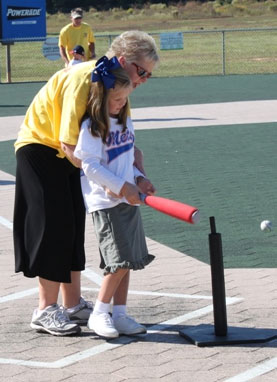 She has been seizure-free since, and has become much more independent — even playing ball this year in Pensacola’s Miracle League.
She has been seizure-free since, and has become much more independent — even playing ball this year in Pensacola’s Miracle League.
“We really had come to accept that Olivia was going to have seizures forever. It was just going to be one of those things we had to deal with. And when God led us to Miami we knew He had other things in store for Olivia. Since the surgery, Olivia has been a whole different child,” mom Amber Bush said. “It is so great to finally after four years of difficult seizures to see Olivia doing the things she always tried to do, but just couldn’t because of the medicines and side effects of the seizures.”
“This has been yet another miracle that God had brought into Olivia’s life,” Amber said. Olivia’s first miracle was life itself — she was the second youngest baby to ever survive at Sacred Heart Hospital. Born at 22 weeks, she weighed just one pound and six ounces.
And now Olivia is a team player at the Miracle League, where every game ends in a tie. Every player hits; every player scores. There are no strikeouts, no errors. Everybody wins.
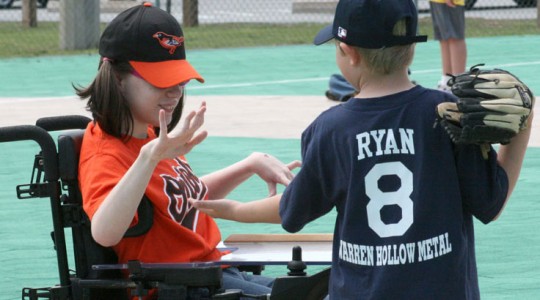 Miracle League is for disabled and special needs persons. With players from ages 3 to 63, there are over a dozen teams that play on the two fields at the Mitchell Homes Miracle League Park on Nine Mile Road.
Miracle League is for disabled and special needs persons. With players from ages 3 to 63, there are over a dozen teams that play on the two fields at the Mitchell Homes Miracle League Park on Nine Mile Road.
“There isn’t one star on the team….all of the kids are stars. All of the buddies cheer for every batter and even high five the kids as they come around the bases,” Amber said.
“Abigail rounds second! She looks good this year, all decked out and playing some ball,” announcer Crystal Martinez says during a recent afternoon game at the Miracle League. “Loooook at her go! She’s headed home! She scores! Yeah Abi!”
That’s just the way a Miracle League game goes — always. Every game for the past 10 seasons had ended in a tie. The stats for each of the over 150 players will be the same at the end of the season — perfect.
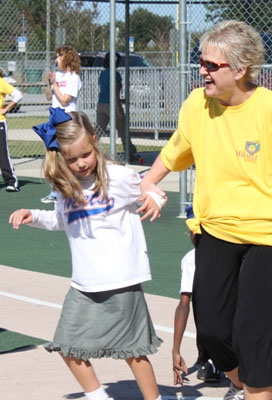 “Olivia has enjoyed herself so much. She loves hearing her name called over the speakers when she comes up to bat and when she scores a run. She just stops and claps her hands,” Amber said.
“Olivia has enjoyed herself so much. She loves hearing her name called over the speakers when she comes up to bat and when she scores a run. She just stops and claps her hands,” Amber said.
Each of the two Pensacola Miracle League fields is made up of 180,000 pounds of recycled tires formed into tiles painted to match a regular field. It provides a softer landing spot for a hard fall, while still providing a good bounce for the hollow core ball that is also designed to lesson injury potential. There are two seasons at the park, spring and fall. The rubber surface gets too hot to play in the summer.
The Miracle League needs more volunteers to serve as buddies, work the concession booth, pickup trash and many more tasks around their area of the Nine Mile Road ballpark.
The public is always welcome and encouraged to cheer on the players.
For more information on Miracle League, or to volunteer, visit www.miracleleaguepensacola.org.
Pictured: Olivia Bush at Saturday’s Miracle League games in Pensacola. NorthEscambia.com photos by Kristi Smith, click to enlarge. Pictured middle inset: A “high five” at a recent Miracle League game, NorthEscambia.com photo, click to enlarge.
FFA Students Compete In Forestry Career Development Event
October 18, 2010
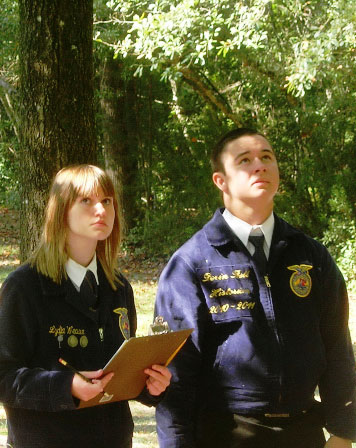 Five Northview High School FFA members recently took part in the District Forestry Career Development event at Ponce de Leon Springs State Park in Marianna.
Five Northview High School FFA members recently took part in the District Forestry Career Development event at Ponce de Leon Springs State Park in Marianna.
Northview FFA Team members participating were Courtney Solari, Stephanie Solari, Lydia Weaver, Devin Bell and Allyson Bullard. Placing in compass measurement were Lydia Weaver, first; Devin Bell, second; and Stephani Solari third.
The purpose of the Forestry Career Development Event is to stimulate student interest in forestry, to promote forestry instruction in the agricultural education curriculum, and to provide recognition for those who have demonstrated skill and competency as a result of forestry instruction, according to event organizers.
For more photos from the event, click here.
Pictured top: Northview FFA Forestry Team members Courtney Solari, Stephanie Solari, Lydia Weaver, Devin Bell and Allyson Bullard. Pictured inset: Weaver and Bell gaze upwards as they work to identify a tree species. Submitted photos for NorthEscambia.com, click to enlarge.
Featured Recipe: Chocolate Truffle Cheesecake That ‘Wows’
October 17, 2010
This weekend’s featured recipe from Janet Tharpe is a Chocolate Truffle Cheesecake. A real show-stopper, this cheesecake is delicious and simple to make.
To print today’s “Just a Pinch” recipe column, you can click the image below to load a printable pdf with a recipe card.
Plan Now For Winter Landscape Color
October 17, 2010
 Even though our landscape may be full of rich colors now, it’s time to start thinking about what it will look like in late winter and early spring. Many of our summer flowering annuals are at the end of their life and will be gone with the first frost. Unless you plan now, you may find your winter landscape as dull as a cold winter day.
Even though our landscape may be full of rich colors now, it’s time to start thinking about what it will look like in late winter and early spring. Many of our summer flowering annuals are at the end of their life and will be gone with the first frost. Unless you plan now, you may find your winter landscape as dull as a cold winter day.
Trees and shrubs are somewhat permanent members of our yards. An annual is defined as a plant that produces flowers and seeds within one growing season and then dies. Their purpose is to provide much desired landscape color.
Most cool-season annuals are planted October through November, but we can continue planting into December, January and even February. Most plants will last until April or May if they’re cared for properly.
Bed preparation
Most flowering annual plants will need a well-drained fertile soil. Adding abundant organic matter will help enrich our typically sandy soils in Northwest Florida.
If drainage is a problem, raise the bed. Commercial landscapers plant flowering annuals on beds raised 6 to 12 inches above the surrounding soil. This assures good drainage and improves visibility. When re-planting old beds, remove old mulch to avoid plant diseases. Top new beds with 4 inches of organic matter (such as compost), and work it into the bed about a foot deep.
Annuals differ in sun and shade requirements. Generally, they thrive best in areas that receive sunlight during much of the day. Locate the bed in areas that meet the light requirements of the plants. Remember that soil pH is important for bedding plants. The recommended pH for most bedding plants is 5.4-6.8. Modify soil pH according to soil test recommendations.
Pansies
No other cool-season bedding plant comes close to pansies in popularity. Don’t plant pansies too early in the fall; it’s probably best to wait until we have our first cold snap.
Numerous flower colors and patterns are available. Plant solid colors in masses for the best visual effect.
 Pansies are heavy feeders and will not perform as well without sufficient fertilizer. Apply a small amount of fertilizer at planting and then again in January. If you’d rather, you may mix a teaspoon of slow-release fertilizer into the soil in each hole as you plant them, and you shouldn’t need to apply more fertilizer later. Alternately, you can fertilize once or twice a month with a soluble fertilizer using a hose-end sprayer.
Pansies are heavy feeders and will not perform as well without sufficient fertilizer. Apply a small amount of fertilizer at planting and then again in January. If you’d rather, you may mix a teaspoon of slow-release fertilizer into the soil in each hole as you plant them, and you shouldn’t need to apply more fertilizer later. Alternately, you can fertilize once or twice a month with a soluble fertilizer using a hose-end sprayer.
The pansies you plant now should last until April or early May of next year. To encourage continued flowering over a longer period, pinch off faded flowers if you can.
Snapdragons
Snapdragons are cool season bedding plants that have good flowering performance in late winter and early spring. Plant in full sun, although snapdragons can tolerate some limited afternoon shade.
Tall, medium and short cultivars are available. The tall types are two to three feet tall, the intermediates are one to two feet tall, the bedding types are six to fifteen inches tall, and the rock garden hybrids are about six inches tall
Dianthus
Dianthus have become one of the most reliable cool season bedding plants. They require a slightly higher pH than some other bedding plants. Plant dianthus in full sun. Flower color will be good through the late fall and winter, but the spring flower performance is excellent.
For more information on annual bedding plants, read the University of Florida online publication at http://edis.ifas.ufl.edu/mg319 or call your local Extension Agent.
Theresa Friday is the Residential Horticulture Extension Agent for Santa Rosa County.. Photo credit - David Marshall.
Photos: Molino Park Elementary’s Annual Fall Carnival
October 16, 2010
 Hundreds attended the annual Molino Park Elementary School Fall Carnival Friday evening at the school. The event featured games, food, entertainment and lots of great family fun.
Hundreds attended the annual Molino Park Elementary School Fall Carnival Friday evening at the school. The event featured games, food, entertainment and lots of great family fun.
NorthEscambia.com photos, click to enlarge.




